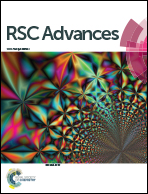Airflow-assisted dielectrophoresis to reduce the resistance mismatch in carbon nanotube-based temperature sensors†
Abstract
The dielectrophoresis (DEP) method is used to fabricate sensor devices by assembling and aligning carbon nanotubes (CNTs) across electrode structures. The challenges of the method increase as the gap width between the electrodes increases. In this work, a novel DEP setup is proposed to reduce the resistance mismatch in manufacturing carbon nanotube-based sensors. The proposed setup utilizes hot airflow and thermal annealing to fabricate long-aligned multi-walled carbon nanotube (MWCNT) bridges across transparent electrodes with a gap width up to 75 μm. The best alignment results were obtained at airflow velocities between 1.5 m s−1 and 2.5 m s−1. The minimum variation in the resistance of the aligned bridges was 1.81% observed at a MWCNT concentration of 0.005 wt% and deposition time of 10 min. Long MWCNT bridges have many contact points that link MWCNTs to each other, making the contact resistance a robust indicator of the variation in the ambient temperature. The characteristics of the MWCNT bridges as a temperature sensor, including the response, sensitivity, and recovery, were investigated.



 Please wait while we load your content...
Please wait while we load your content...